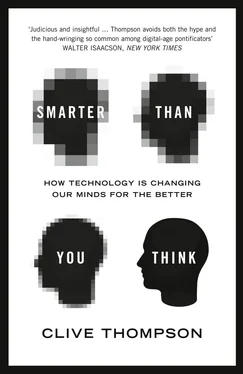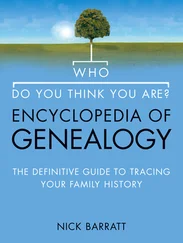I want to examine how technology changes our mental habits, but for now, we’ll be on firmer ground if we stick to what’s observably happening in the world around us: our cognitive behavior, the quality of our cultural production, and the social science that tries to measure what we do in everyday life. In any case, I won’t be talking about how your brain is being “rewired.” Almost everything rewires it, including this book.
The brain you had before you read this paragraph? You don’t get that brain back. I’m hoping the trade-off is worth it.
The rise ofadvanced chess didn’t end the debate about man versus machine, of course. In fact, the centaur phenomenon only complicated things further for the chess world—raising questions about how reliant players were on computers and how their presence affected the game itself. Some worried that if humans got too used to consulting machines, they wouldn’t be able to play without them. Indeed, in June 2011, chess master Christoph Natsidis was caught 37illicitly using a mobile phone during a regular human-to-human match. During tense moments, he kept vanishing for long bathroom visits; the referee, suspicious, discovered Natsidis entering moves into a piece of chess software on his smartphone. Chess had entered a phase similar to the doping scandals that have plagued baseball and cycling, except in this case the drug was software and its effect cognitive.
This is a nice metaphor for a fear that can nag at us in our everyday lives, too, as we use machines for thinking more and more. Are we losing some of our humanity? What happens if the Internet goes down: Do our brains collapse, too? Or is the question naive and irrelevant—as quaint as worrying about whether we’re “dumb” because we can’t compute long division without a piece of paper and a pencil?
Certainly, if we’re intellectually lazy or prone to cheating and shortcuts, or if we simply don’t pay much attention to how our tools affect the way we work, then yes—we can become, like Natsidis, overreliant. But the story of computers and chess offers a much more optimistic ending, too. Because it turns out that when chess players were genuinely passionate about learning and being creative in their game, computers didn’t degrade their own human abilities. Quite the opposite: it helped them internalize the game much more profoundly and advance to new levels of human excellence.
Before computers came along, back when Kasparov was a young boy in the 1970s in the Soviet Union, learning grand-master-level chess was a slow, arduous affair. If you showed promise and you were very lucky, you could find a local grand master to teach you. If you were one of the tiny handful who showed world-class promise, Soviet leaders would fly you to Moscow and give you access to their elite chess library, which contained laboriously transcribed paper records of the world’s top games. Retrieving records was a painstaking affair; you’d contemplate a possible opening, use the catalog to locate games that began with that move, and then the librarians would retrieve records from thin files, pulling them out using long sticks resembling knitting needles. Books of chess games were rare and incomplete. By gaining access to the Soviet elite library, Kasparov and his peers developed an enormous advantage over their global rivals. That library was their cognitive augmentation.
But beginning in the 1980s, computers took over the library’s role and bested it. Young chess enthusiasts could buy CD-ROMs filled with hundreds of thousands of chess games. Chess-playing software could show you how an artificial opponent would respond to any move. This dramatically increased the pace at which young chess players built up intuition. If you were sitting at lunch and had an idea for a bold new opening move, you could instantly find out which historic players had tried it, then war-game it yourself by playing against software. The iterative process of thought experiments—“If I did this , then what would happen?”—sped up exponentially.
Chess itself began to evolve. “Players became more creative and daring,” as Frederic Friedel, the publisher of the first popular chess databases and software, tells me. Before computers, grand masters would stick to lines of attack they’d long studied and honed. Since it took weeks or months for them to research and mentally explore the ramifications of a new move, they stuck with what they knew. But as the next generation of players emerged, Friedel was astonished by their unusual gambits, particularly in their opening moves. Chess players today, Kasparov has written, “are almost as free of dogma as the machines with which they train. Increasingly, a move isn’t good or bad because it looks that way or because it hasn’t been done that way before. It’s simply good if it works and bad if it doesn’t.”
Most remarkably, it is producing players who reach grand master status younger. Before computers, it was extremely rare for teenagers to become grand masters. In 1958, Bobby Fischer stunned the world by achieving that status at fifteen. The feat was so unusual it was over three decades before the record was broken, in 1991. But by then computers had emerged, and in the years since, the record has been broken twenty times, as more and more young players became grand masters. In 2002, the Ukrainian Sergey Karjakin became one at the tender age of twelve. 38
So yes, when we’re augmenting ourselves, we can be smarter. We’re becoming centaurs. But our digital tools can also leave us smarter even when we’re not actively using them.
Let’s turn to a profound area where our thinking is being augmented: the world of infinite memory.
Конец ознакомительного фрагмента.
Текст предоставлен ООО «ЛитРес».
Прочитайте эту книгу целиком, купив полную легальную версию на ЛитРес.
Безопасно оплатить книгу можно банковской картой Visa, MasterCard, Maestro, со счета мобильного телефона, с платежного терминала, в салоне МТС или Связной, через PayPal, WebMoney, Яндекс.Деньги, QIWI Кошелек, бонусными картами или другим удобным Вам способом.












